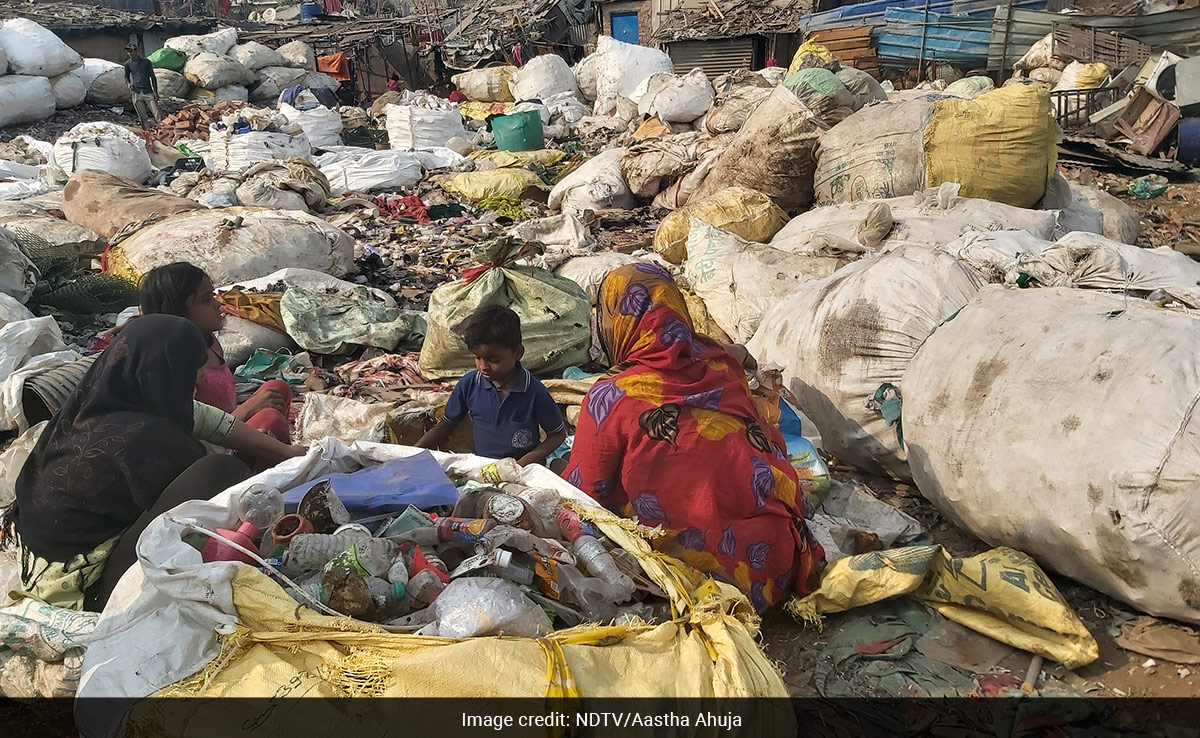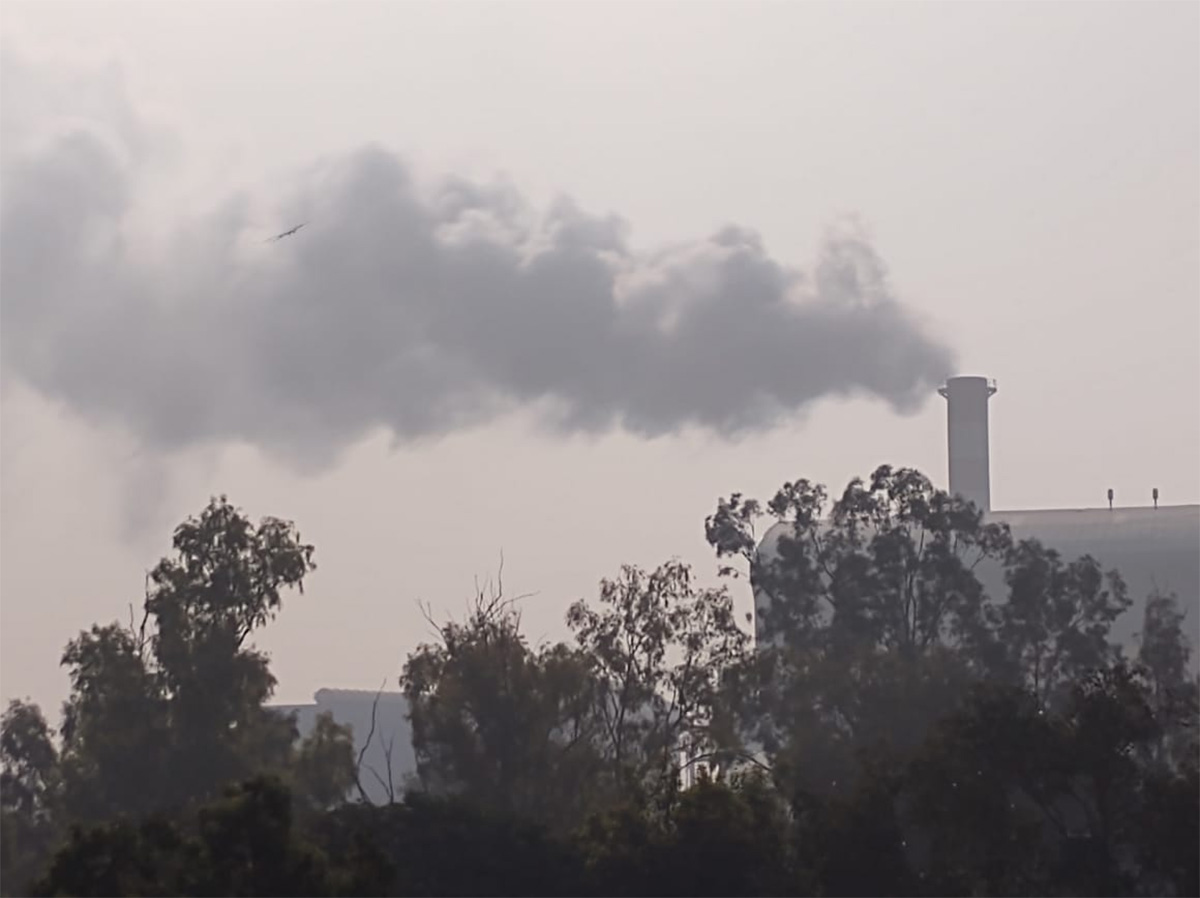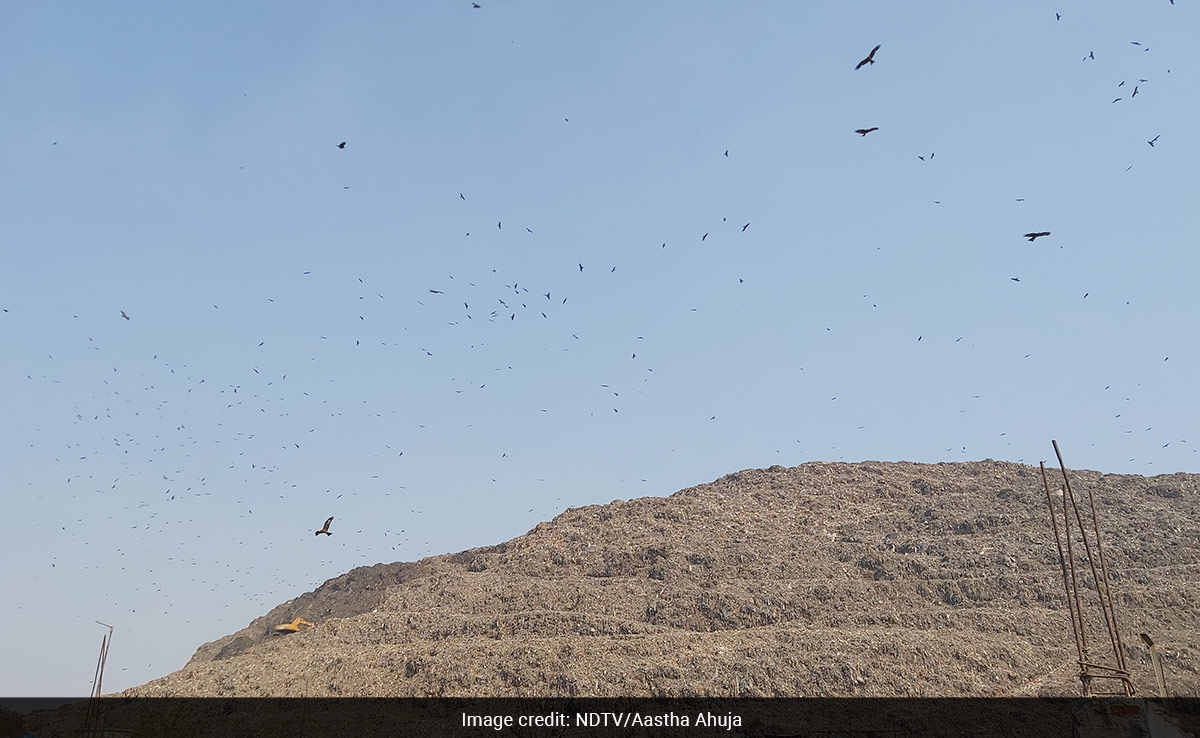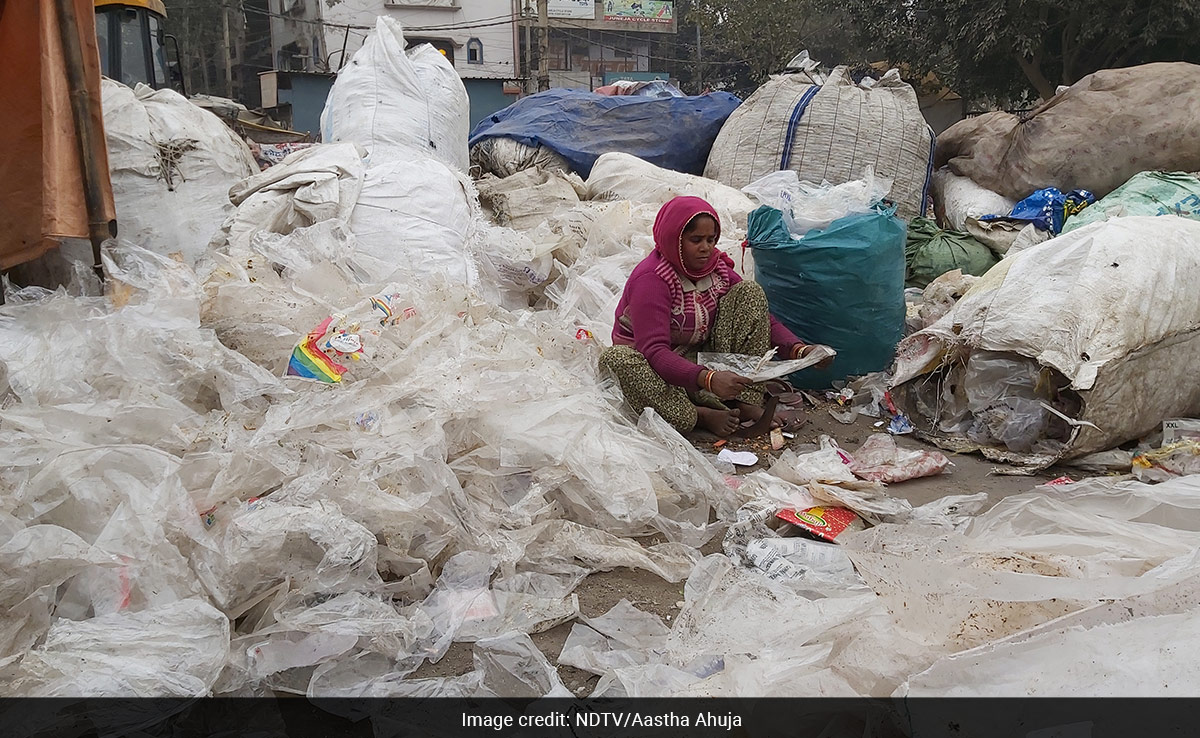New Delhi: It is quarter to 1 pm in January, the winter sun is shining bright, providing respite from Delhi’s chilly temperatures. Amaruddin is disappointed. Attired in ragged trousers and an old, half-sleeve pink T-shirt that may have seen better days, Amaruddin is walking empty-handed towards his home in the narrow by-lanes of Ghazipur.
“I went to the dumpsite but didn’t get any valuable waste to bring home,” he says, justifying his early return.
Amaruddin, who hails from West Bengal, came to Ghazipur, an area near the Delhi-Ghaziabad border, with his father in search of a better life. Amaruddin’s father used to collect and sort waste at the Ghazipur dumpsite – the oldest site in Delhi commissioned in 1984 – for a living. Carrying forward his legacy are Amaruddin and his brother Allahuddin.
“Waste picking job is demanding. You have to climb the mountain every day and look through the waste. It takes 25 minutes to reach the top,” says Amaruddin.
When working at the garbage dump, I slog for two days, followed by a day’s rest to recover from the physical exhaustion.
Also Read: Garbage Mountains – Dotting The Landscape Of Delhi
In the last 20 years, Amaruddin has tried his hands at multiple jobs – as a waste worker at a dumpsite, a helper at a shop and even at Waste-to-Energy (WTE) plant for three to four years.
“At a WTE plant, I used to earn Rs. 12,000 per month, less than what I make from the dumpsite, but I was satisfied because there was a fixed income and a sense of safety and security,” he says.
Many years ago, the plant was shut for maintenance and I lost the job. We were assured that we will be hired back in six months, but when the plant reopened, they got new machines and new labour from other parts of the country. Some people even paid to get a job.
Currently, Amaruddin is out of work, as the fresh Municipal Solid Waste (MSW) coming to Ghazipur has reduced to around 1,500 Tonnes Per Day (TPD) from 2,000-2,200 TPD until very recently. In addition, trommel machines have been placed at the dumpsite to treat legacy waste that has piled up over the decades, creating a man-made trash mountain of around 40 meters.
In 2019, the height of the Ghazipur dumpsite was 65 meters (213 feet) high, only eight meters short of Qutub Minar, a UNESCO heritage site in Delhi. As per the data received from the MCD, 280 lakh tonnes of legacy waste has been dumped on the three dumpsites as of July 2019, with 140 lakh tonnes on the Ghazipur site alone.
Amaruddin’s income supports his wife, two young kids, aged 5 and 3, a blind mother and a father who suffers from Tuberculosis. He expects at least one person from the family, who has lived off these waste mountains, to get a job at the WTE.
Nove Bibi, 45, another resident of a colony adjoining the dumpsite, feels that waste management “has now become a man’s job”. Around 16 years ago, Nove Bibi along with her young kids arrived by train to Delhi from Kolkata without a ticket. A courageous woman, she made the move to escape the abuse she and her children suffered in the hands of her drug-addict husband.
“I don’t like Delhi anymore,” says Nove Bibi. “The dumpsite is shut. The height of the dump yard has increased many folds, making it difficult for us to climb. Men can still find work, but where will I go at this age? People who have land can practice farming. What will I do? I want to work. Give me work,” she pleads.
Also Read: Living In The Shadows Of Asia’s Largest Garbage Mountain, The Ghazipur Landfill
Nove Bibi’s daughter, Manjura, used to work at a WTE plant for Rs. 15,000 a month. This was before the plant stopped hiring women.
“Going to a dumpsite is physically taxing, as it is one tall mountain, and my back and legs hurt,” says Manjura.
Whereas, at WTE, you work eight hours a day, six days a week, and get a decent sum of money. The work there is good. Provide me with work at WTE and I will do it happily.
NDTV’s team Banega Swasth India tried reaching out to the WTE plant official in Ghazipur to validate the claims made by the informal sector waste workers about losing their jobs at the plant because of maintenance and lay-offs, but didn’t get any response.
Dumpsites: Health And Environmental Hazard
Experts state that physical weariness is nothing compared to the severe health hazards one is exposed to in and around dumpsites which carry all sorts of waste. The biodegradable or wet waste decomposes over time. The anaerobic decomposition (breakdown of organic waste in the absence of oxygen) of organic waste generates methane gas, which is flammable and gives rise to heat—which explains why many dumpsites in Delhi catch fire during summer months, or are always smoldering with slow flames in some areas.
According to the data received from Delhi Fire Services, the Department received 33 fire calls each from Bhalswa and Okhla dumpsite and 23 from Ghazipur between 2019 and 2022.
“Mixed waste (at dumpsites) catching fire releases dioxins and furans, toxic chemicals which are carcinogenic in nature. There are other harmful gases like Methane and H2S (Hydrogen Sulfide), as well as high levels of Particulate Matter and Ammonia,” says Dr. Richa Singh, Deputy Programme Manager, MSW (Municipal Solid Waste) team, Centre for Science and Environment.
Long-term exposure to these gases can result in respiratory disorders, and at times it can lead to cancer as well.
NDTV team tried visiting the Ghazipur dumpsite but was stopped at the entrance by the representatives of the MCD because of the “dangerous gases” and the “risk of the mountain of garbage collapsing”.
Also Read: Solid Waste Management In India: The Challenge Of Growing Mountains Of Garbage – Landfills
A walk around any of the three dumpsites in Delhi is impossible without covering one’s nose. A thriving breeding ground for flies and mosquitoes that can cause various vector borne diseases, the potential health hazard of these dumpsites are quite worrying given the contamination they cause of air, groundwater and the overall surroundings. But people like Amaruddin and Nove Bibi are indifferent to it as for them it is a matter of livelihood over health.
They say they discover a variety of products in the garbage: sanitary waste, bio-medical waste such as COVID masks and gloves, e-waste such as used batteries, and many other hazardous items.
“When waste pickers collect garbage with their bare hands, they often get injured as sharps are lying around. They inhale toxic fumes daily. These people have headaches, nausea, gastroenteritis, and spinal problems. While we can criticise and say why these people live here if it is hazardous, it is their livelihood,” says Chitra Mukherjee, Consultant, Waste and Sustainable Livelihood.
A report titled “Assessment of the amount of damage to environment on account of dumpsites in Delhi” in January 2021 by a joint committee of the Central Pollution Control Board (CPCB), National Environmental Engineering Research Institute and IIT Delhi revealed “high level of Chemical Oxygen Demand (COD) and Fe (Iron) in ground water at all three sites” which may be due to leachate from the dumpsite.
“Very high levels of COD, Chloride, Total Dissolved Solids (TDS), Total Soluble Solids (TSS), and turbidity were reported in the surface water body (Bhalswa lake) located within a radius of 0-1 km from the Bhalswa site, which may be due to leachate from the dumpsite,” according to the report.
Waste-To-Energy Plants: A Solution?
A waste-to-energy plant is a technology that uses waste to generate electricity. Currently, Delhi has four operational waste-to-energy plants at Okhla, Ghazipur, Bawana, and Tehkhand. Together, they process 6,078.5 tonnes of fresh waste and 828 tonnes of Refused Derived Fuel (RDF) that comes from the dumpsites. Along with this, two more WTEs are proposed – one at Narela-Bawana and another at Ghazipur. The expansion of existing WTEs at Okhla and Bawana has also been proposed.
As per Solid Waste Management Rules, 2016 only non-recyclable waste with a calorific value of 1500 K/cal/kg or more should be utilised in WTE plants. However, as per the information shared by the MCD, all WTEs in Delhi receive mixed waste.
“These are expensive plants, requiring constant monitoring. The way electricity is produced is negligible. It doesn’t take care of any of our electricity needs in the city. Also, waste generated in India is low in calorific value, high in moisture content, and is less than 1500 K/cal/kg. We are using a lot of the government’s money on a technology that really doesn’t work in the Indian context”, says Ms Mukherjee.
It’s being used because incineration is an easy option. As an alternative, we should consider reusing, recycling and composting.
Also Read: Garbage Management Crisis: How Effective Are Waste To Energy Treatment Plants?
Instead of becoming a solution, WTE plants have become an added problem, say experts like Ms. Mukherjee. A case in point is the Okhla plant, located 35 meters away from 806 DDA SFS Flats of Pocket A and Pocket B of Sukhdev Vihar, which is in close vicinity of densely populated colonies of Hajji Colony, Gajar Manjil, and Noor Nagar. The pollution caused by Okhla WTE is such that the doctors are now advising residents to relocate, if possible.
Polluted particles deposit on the lungs and cause respiratory distress. People with compromised immunity, children, the elderly and pregnant women are at a higher risk of developing infections and diseases.
“My patients have reported an increase in instances of dermatitis, itching, hypertension and constant headache,” says Dr. Neeta Mishra, Senior Consultant at Apollo Hospitals and a gynecologist, who runs Divine Clinic in Sukhdev Vihar.
Pregnant women tell me that when they move to some other part of Delhi, like if they stay at their relative’s place because of this additional burden of pollution coming from WTE, they feel better.
Air pollution can shorten lives by almost 10 years in the Indian capital, Delhi, the world’s most polluted city, according to the Air Quality Life Index 2022, produced by the Energy Policy Institute at the University of Chicago (EPIC). The toxic gases released from WTE add to the pollution burden.
With mothers getting less oxygen or clean air to breathe, babies’ IQ can be affected. We are playing with the health of our future generations, says Dr. Mishra.
Also Read: Disease, Disability And Death: Impact Of Exposure To Air Pollution
Dr. Shailendra Bhadoriya, Consultant Cardiologist at BLK-Max Super Speciality Hospital moved to Sukhdev Vihar in 2011, when the Okhla WTE started its operations. According to him, his four-member family developed asthma ever since they moved here because of work.
“We see fumes coming out of the WTE plant. Sometimes they are shadowed by the fog and pollution,” says Dr. Bhadoriya, whose children are aged 5 and 12.
We moved here because I used to work at Fortis Escorts Heart Institute in this area. None of us were asthmatic before we shifted to this place. Today, we all are asthmatic. My son got admitted to ICU twice in the last six months.
Concerned about health hazards from toxic fumes, the residents of Sukhdev Vihar filed a petition in 2009 seeking to invoke Article 21 of the Constitution of India which ensures the “Right to Life”.
The petition sought relief as such: “Public Interest Litigation (PIL) under Article 226 of the Constitution of India praying that the construction of the proposed Waste to Energy plant close to Okhla STP (Sewage Treatment Plant) should be stopped”.
While court proceedings continued, in January 2011, Okhla WTE, namely Timarpur Okhla Waste Management Company Ltd. started its operations.
After four years, in February 2013, the case moved to the National Green Tribunal (NGT) where the plant manager M/s Jindal Infrastructure Ltd. refuted all allegations of the Sukhdev Vihar Residents’ Welfare Association stating, “It is specifically denied that the impact of the plant will endanger the lives of the residents and there would be a constant foul smell that will suffocate the atmosphere. Now, when the plant is in operation, there is no odour of municipal solid waste. The plant is a state-of-the-art facility for the purpose of MSW processing.”
But, the varied assessments paint a different picture.
Ranjit Devraj, a Resident of Sukhdev Vihar took us through the timeline of the legal proceedings as he has been actively involved in the case.
In April 2013, testing by the Delhi Pollution Control Committee (DPCC) showed dioxins and furans being emitted by the plant. In September 2013 again DPCC reported high levels of dioxins and furans. Later, in November 2016, the NGT warned the plant operator that it will order a shutdown after DPCC admits that there are high levels of pollution coming out of the plant, said Mr. Devraj.
After multiple proceedings, in January 2017, the NGT granted permission for the plant to operate on the condition that it “would not cause any environmental pollution”. The NGT also levied Environmental Compensation of Rs. 25 lakh “for the pollution resulting from deficient functioning/operation of ‘Waste to Energy Plant’ and its stack emissions being in excess of prescribed parameters up to the period of December 18, 2014.”
Dissatisfied with the hearing, in May 2017, the residents challenged the decision in the Supreme Court and currently, the case is pending. They appealed for an urgent hearing earlier this year in January, given the Ministry of Environment, Forest and Climate Change accorded environment clearance for the expansion of the Waste to Energy plant upto 40MW.
“The matter is sub judice. The WTE plant used to be polluting. But, as he (Commissioner Gyanesh Bharti) says, we are complying with the CPCB norms. If the residents of Sukhdev Vihar are still agitated, I will check,” said CM Arvind Kejriwal during a press briefing after his visit to the Bhalswa dumpsite on March 16.
WTE plants cause severe environmental damage and there is evidence to support that. Despite this, the MCD is looking to establish more WTEs and expand the capacity of the existing ones.
“Delhi is a landlocked city with a scarcity of land. A WTE plant set-up on 15 acres of land helps manage 3,000 TPD of waste. There is no better waste processing facility. On the contrary, a bio-CNG plant of capacity 300 TPD requires six to seven acres of land”, says Dinesh Yadav, Chief Engineer at the Department Of Environmental Management at the MCD.
In our new contracts, like for WTE in Narela, we have put a disincentive mechanism that the operator will have to pay Rs. 300 per metric of bottom ash. This means, now the WTE plant operator will try to take care of bottom ash at his end instead of sending it to dumpsites.
While answering NDTV’s team’s question on WTEs, CM Arvind Kejriwal supported the use of the technology and said the city is generating electricity from waste.
“In most waste-to-energy plants, segregation of waste is not necessary anymore,” he said.
However, in an exclusive interview with Banega Swasth India, Reena Gupta, Advisor, Government of Delhi opposed WTEs. “We are very clear, we don’t want any more WTEs in Delhi. These are highly polluting and WTEs are not meant for populations like us. But, we want to look at the existing WTEs and see if we can change their technology. Is it possible that they become less polluting than they are right now?” she asks.
Delhi’s Waste Management Plan Excludes A Skillful Resource – Waste Workers
The transition to technologies like WTE plants is not only impacting the environment but has also come with a big hit to waste workers, a transition that has not been just.
The SWM Rules define a “waste picker as a person or groups of persons informally engaged in collection and recovery of reusable and recyclable solid waste from the source of waste generation, the streets, bins, material recovery facilities, processing and waste disposal facilities for sale to recyclers directly or through intermediaries to earn their livelihood.”
Also Read: Understanding Solid Waste Management Rules 2016
As per Ms. Mukherjee, Delhi relies on a largely informal sector of over 1,50,000 waste workers to collect, segregate and recycle 20-25% of its waste. Yet they remain unacknowledged and unrewarded.
They provide an essential service of door-to-door waste collection and segregation. This helps prevent the creation of more landfills as recyclable dry waste is segregated out of the waste stream and recycled.
“Ek time esa tha, insaan ko kisi cheez ki kami nahi hone di is khatte ne (There was a time when the dumpsite used to fulfill all our needs),” says 28-year-old Sheikh Ibrahim, who lives around the Ghazipur dumpsite.
Mr. Ibrahim, the youngest of three children, has been going to the dumpsite for the past 19 years to make a living.
The food waste from the nearby hotels would also come to the Ghazipur dumpsite. From fruits, rice, bread to pulses, sometimes drivers would bring food from nearby hotels for the kids of the ragpickers, he says. Pet ke liye jaana padta hai. Rozi roti kamane ke liye (We have to go to the dump site every day and deal with waste to earn our daily bread).
Mr. Ibrahim says that an individual’s daily earnings from the dumpsite vary from person to person, as it depends on how often one visits the garbage dump and how much time one spends collecting and sorting waste.
Back in the day, one could earn Rs. 500 to Rs. 1,000 a day but now it has come down to zero. Machines are being used to bring down the height of the dumpsite and clear up the legacy waste which is why fresh waste from East Zone is not discarded here anymore, he adds.
Also Read: Solid Waste Management In India: The Challenge Of Growing Mountains Of Garbage – Landfills
For a couple of years, Mr. Ibrahim also worked at the WTE plant in Ghazipur set up by IL&FS Environment on a Public Private Partnership framework.
I would bring home Rs. 14,000, post deduction of money for the Provident Fund. However, there were irregularities in salary and when we raised our voice against it, we were laid off. The plant was then shut off for six months for maintenance purposes and we were told that they will hire us back but nothing of that sort happened, he says.
The Solid Waste Management Rules 2016 and Plastic Waste Management Rules 2016 have mandated the inclusion of informal waste workers in waste management but the on-ground reality is different.
“A legal framework is required to ensure an inclusive and fair transition of waste pickers and other informal workers in the waste value chain, allowing them decent work opportunities in times where increasingly private actors are competing for access to waste,” says Ms. Mukherjee.
Team Banega Swasth India asked CM Kejriwal about his government’s plan to provide an alternative source of livelihood for waste workers. He said,
I don’t think there is any systematic plan. Let me find out.
Experts believe that a just transition can take place if we consider protecting the incomes and livelihoods of waste workers by including them in the country’s waste management planning.
“The municipality needs to register waste pickers to set up authorised 100% doorstep collection of waste and ensure only non-recyclable waste goes to landfills,” adds Ms. Mukherjee.
Dr. Singh suggests taking lessons from cities like Indore, Pune and Ambikapur that have got waste management in place right from source segregation. Pune Municipal Corporation (PMC) signed an MoU with SWaCH (Solid Waste Collection and Handling), a cooperative wholly owned by waste pickers/collectors, to decentralise the door-to-door collection of waste.
The cooperative members collect segregated waste from over 2,000 households. The non-recyclable waste is further segregated for sale, while the wet/organic and non-recyclable waste is dropped off at PMC ‘feeder points,’ from where it is collected by the municipal garbage trucks and sent to the landfill.
“The plan is to involve them (waste workers). Without them, there is no way waste management can actually work. Whenever we redesign the waste collection/management contracts, we will make sure that the informal waste speakers are taken care of,” says Ms. Gupta.
As Delhi struggles to manage its waste and seeks solutions, it has lessons to learn from cities like Indore, Pune and Ambikapur, where municipal corporations work effectively with waste collectors.
This report was written and produced as part of a media skills development program delivered by Thomson Reuters Foundation. The content is the sole responsibility of the author and the publisher.
NDTV – Dettol have been working towards a clean and healthy India since 2014 via the Banega Swachh India initiative, which is helmed by Campaign Ambassador Amitabh Bachchan. The campaign aims to highlight the inter-dependency of humans and the environment, and of humans on one another with the focus on One Health, One Planet, One Future – Leaving No One Behind. It stresses on the need to take care of, and consider, everyone’s health in India – especially vulnerable communities – the LGBTQ population, indigenous people, India’s different tribes, ethnic and linguistic minorities, people with disabilities, migrants, geographically remote populations, gender and sexual minorities. In wake of the current COVID-19 pandemic, the need for WASH (Water, Sanitation and Hygiene) is reaffirmed as handwashing is one of the ways to prevent Coronavirus infection and other diseases. The campaign will continue to raise awareness on the same along with focussing on the importance of nutrition and healthcare for women and children, fight malnutrition, mental wellbeing, self care, science and health, adolescent health & gender awareness. Along with the health of people, the campaign has realised the need to also take care of the health of the eco-system. Our environment is fragile due to human activity, which is not only over-exploiting available resources, but also generating immense pollution as a result of using and extracting those resources. The imbalance has also led to immense biodiversity loss that has caused one of the biggest threats to human survival – climate change. It has now been described as a “code red for humanity.” The campaign will continue to cover issues like air pollution, waste management, plastic ban, manual scavenging and sanitation workers and menstrual hygiene. Banega Swasth India will also be taking forward the dream of Swasth Bharat, the campaign feels that only a Swachh or clean India where toilets are used and open defecation free (ODF) status achieved as part of the Swachh Bharat Abhiyan launched by Prime Minister Narendra Modi in 2014, can eradicate diseases like diahorrea and the country can become a Swasth or healthy India.





































